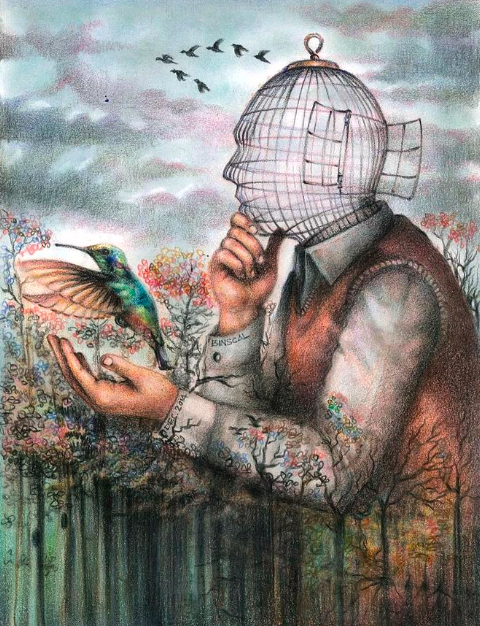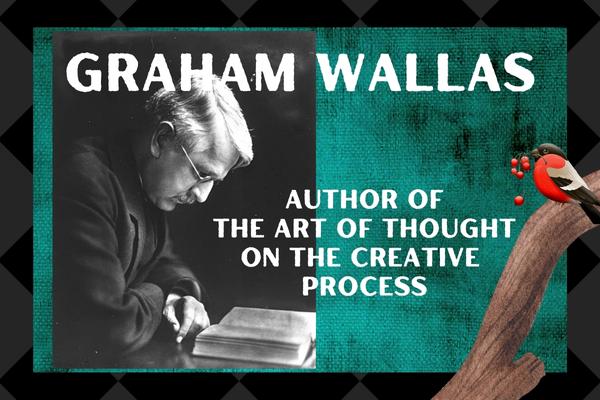Graham Wallas, (born May 31, 1858, Sunderland, Eng.—died Aug. 10, 1932, London), was an English scholar.
Wallas was also the author of the highly influencial book The Art of Thought (read a copy free online).
In the book, he proposed one of the first formal models of the creative process of the 20th century.
Simple and insightful, this model has continued to inspire creative people throughout the world.
This article introduces you to Wallas’s description of that creative process.
This model is still used today.
Not only was Graham Wallas (1858-1932) an English scholar and author he is also the co-founder of the London School of Economics.
Wallas’s areas of expertise were:
- social psychology and…
- the study of how thoughts, feelings, and behaviors of individuals are influenced by social situations. <– I find this particularly fascinating and relevant.
Near the end of his professional life – after 40 years as a teacher and administrator, along with authoring multiple influential books – he published his last major work:
The Art of Thought

His goal was to uncover the ‘natural thought process’ of creativity, and teach it to others.
In the preface Wallas states:
“If my book helps a few young thinkers in the practice of their art, or induces some other psychological inquirer to explore the problem with greater success than my own, I shall be more than content.”
Wallas met his goal, and more.
The Art of Thought has influenced many thinkers worldwide and has been the foundation of significant continued research on the creative process.
The Creative Process in Wallas’ Words
In seeking to discover “the ‘natural’ thought process…”, Wallas said;
“We can … take a single achievement of thought – the making of a new generalization or invention, or poetical expression of a new idea – and ask how it was brought about.
We can then roughly dissect out a continuous process, with a beginning and a middle and an end of its own.”
Doing exactly that, Wallas refers to a 1891 speech made by German Physicist, Hermann von Helmholtz, who was known for contributions in energy, electrodynamics, and thermodynamics, during which the physicist described his process for creating new ideas.
In the speech, Helmholtz said that after previous investigation of the problem;
“in all directions… happy ideas come unexpectedly without effort, like an inspiration. So far as I am concerned, they have never come to me when my mind was fatigued, or when I was at my working table…. They came particularly readily during the slow ascent of wooded hills of a sunny day.”
Then, Wallas deconstructs Helmholtz description into three pieces and adds a fourth.
Wallas says (bullets added);
“Helmholtz here gives us three stages in the formation of a new thought.
- The first in time I shall call Preparation, the stage during which the problem was ‘investigated… in all directions’;
- the second is the stage during which he was not consciously thinking about the problem, which I shall call Incubation;
- the third consisting of the appearance of the ‘happy idea’ together with the psychological events which immediately preceded and accompanied that appearance, I shall call Illumination.
- And I shall add a fourth stage, of Verification, which Helmholtz does not mention here.”
Other articles on these phases of the creative process can be found here:
and here… Exploring Spontaneous Creativity
Wallas then elaborates on the meaning of verification by referring to Henri Poincaré, a 19th century French mathematician, physicist and engineer who was known for his contributions to chaos theory, topography, and more.
Summarizing Wallas’s thoughts on Poincare’s work he wrote;
“In both cases Incubation was preceded by a Preparation stage of hard, conscious, systematic, and fruitless analysis of the problem.
In both cases the final idea came to him ‘with the same characteristics of conciseness, suddenness, and immediate certainty’.
Each was followed by a period of verification, in which both the validity of the idea was tested, and the idea itself was reduced to exact form.
‘It never happens,’ says Poincaré… ‘that unconscious work supplies ready-made the result. All that we can hope for from these inspirations, which are the fruit of unconscious work, is to obtain points of departure for such calculations.
As for the calculations themselves, they must be made in the second period of conscious work which follows the inspiration, and in which the results of the inspiration are verified and the consequences deduced.
The results of these calculations are strict and complicated; they demand discipline attention, will, and consequently, consciousness.”
Wallas uses Helmholtz and Poincaré views to describe the four stages of creativity, merely as points to back up his own.
In fact, he expresses that his insights on this method have come mostly from his own experience.
As well, Wallas pulled from the accounts of poets and artists on their own thought-processes, his students, and by friends in England and America.”
In this, I take comfort and recognition.
TIPS On Improving Your Art – It’s All About YOUR Uniqueness
POD Shop: https://fineartamerica.com/profiles/seek-craft
ALL Social Media: https://linktr.ee/seekcraft1
Email: thewritersnexus@gmail.com

![Graham Wallas, around the time he wrote The Art of Thought (1926) [1].](https://images.squarespace-cdn.com/content/v1/5d6700e799e03b0001e82f2b/1616638119653-OX26T3C9ECYQ84L3LIBA/Graham_Wallas%2C_c1920s.jpeg)